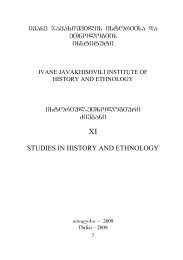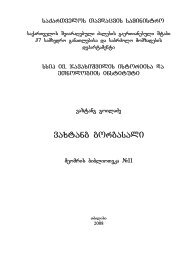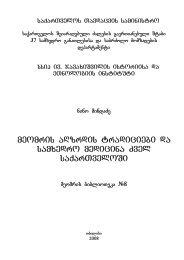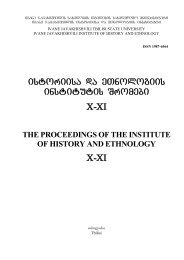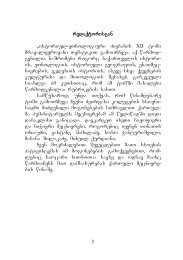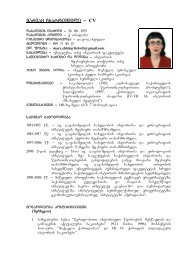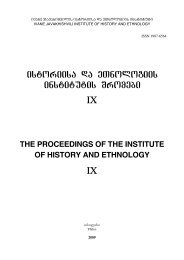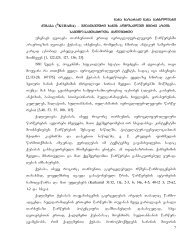programa "logosi"
programa "logosi"
programa "logosi"
Erfolgreiche ePaper selbst erstellen
Machen Sie aus Ihren PDF Publikationen ein blätterbares Flipbook mit unserer einzigartigen Google optimierten e-Paper Software.
nilia erT SemTxvevaSi kelaptriT anu xe-sanTliT, sxva<br />
SemTxvevaSi xe-cxeniT an xe-xariT; iseve rogorc yabaxSi Sejibris<br />
dros xe _ frinveliT.<br />
religiuri kompleqsi: saflavi-xe-Sewiruli cxoveli (cxeni<br />
an xari), an maTi Semcvleli kelaptari TavisTavad umaRlesi<br />
realobis niSania, romelSic farTo kosmologiuri azri<br />
devs da Sesabamisad, samyaros "centrisa" da "samyaros RerZis"<br />
aRmniSvnelia eliadeseuli gagebiT, rac niSnavs, rom saflavs,<br />
rogorc kosmizirebul sivrces Tavisi centri aqvs gardacvlilis<br />
saxiT da RerZi (xe-cxeni, xe-iremi, xe-xari, kelaptari,<br />
jijbaxi) saxiT.<br />
Nino Abakelia<br />
SACRED TREE AND ITS ALLOMORPHIC VARIATIONS IN<br />
THE MORTUARY AND MOURNING CUSTOMS OF<br />
GEORGIA<br />
Burial customs and the rituals associated with them in traditional culture<br />
represent mythologized relations between the living and the dead, descendents<br />
and their ancestors, between the world of the living and the world of<br />
the deceased (the Nether world). In these mythologized customs of the<br />
mortuary rituals the sacred tree has its definite place and role.<br />
In Georgian culture as well as in many other cultures the sacred tree is<br />
associated with the different phases of human life. But in every concrete<br />
case the sacred tree reveals different information.<br />
In this paper a ritual object, called kelaptari (i.e. artificial waxen tree),<br />
made by close relatives or nurses of the deceased and brought to the funeral,<br />
after forty days or at the annual commemorative ceremonies, is considered<br />
to be a variation of the sacred tree.<br />
Relatives of the deceased dressed in mourning clothes, riding horses and<br />
on foot moved in procession from the far villages. They carried a big kelaptari<br />
in front of them, which was held by the grief-stricken woman (or if it<br />
was too heavy, it was carried by several men). Passing villages, lamenting<br />
women screamed loudly so that everybody guessed that somebody had died<br />
and the procession moved towards the village of the deceased.<br />
The survived data in different parts of Georgia describing the custom are<br />
complementary to each other and gives more or less complete and clear<br />
picture of it.<br />
41





